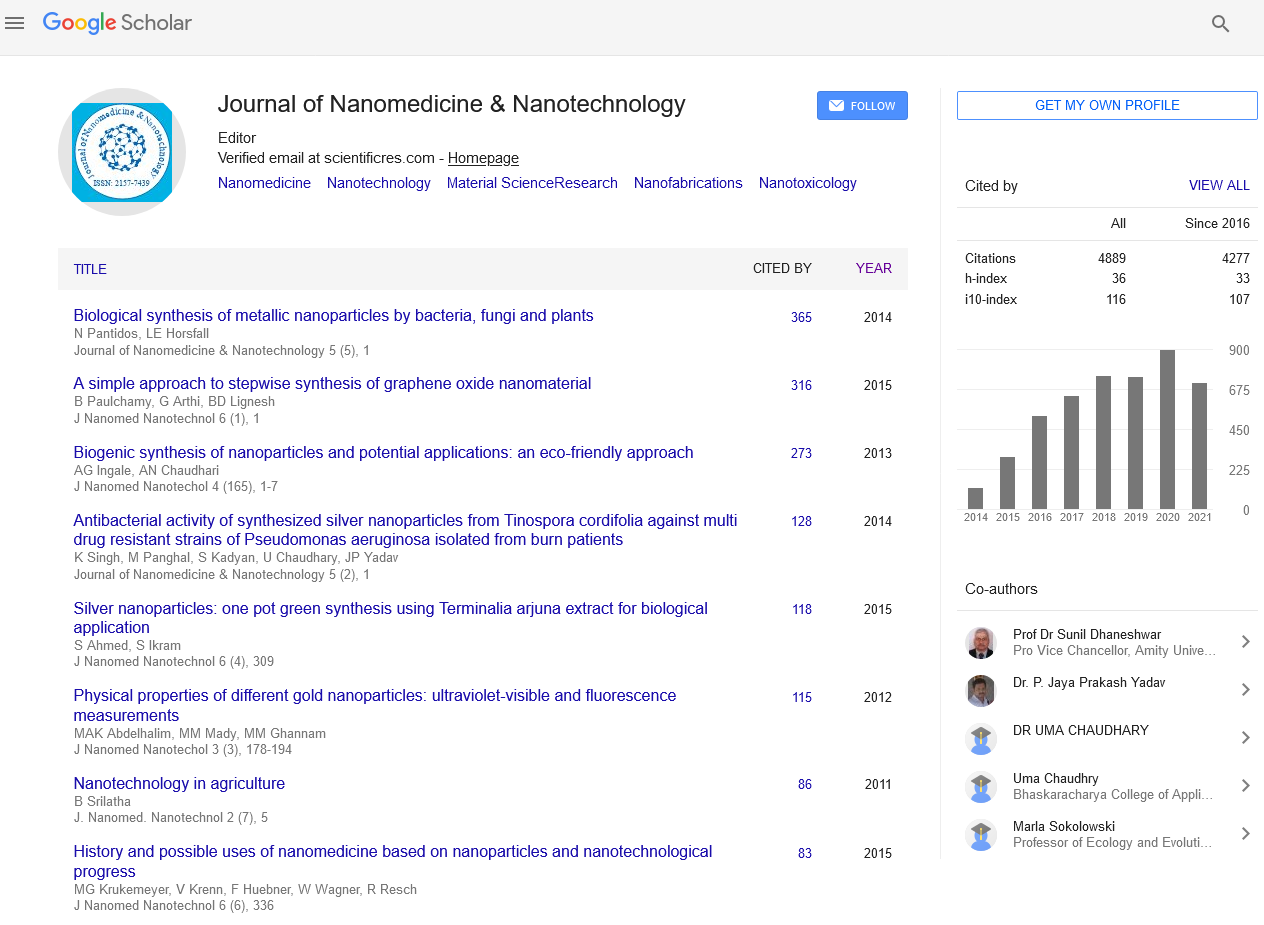Indexed In
- Open J Gate
- Genamics JournalSeek
- Academic Keys
- JournalTOCs
- ResearchBible
- China National Knowledge Infrastructure (CNKI)
- Scimago
- Ulrich's Periodicals Directory
- Electronic Journals Library
- RefSeek
- Hamdard University
- EBSCO A-Z
- OCLC- WorldCat
- SWB online catalog
- Virtual Library of Biology (vifabio)
- Publons
- MIAR
- Scientific Indexing Services (SIS)
- Euro Pub
- Google Scholar
Useful Links
Share This Page
Journal Flyer
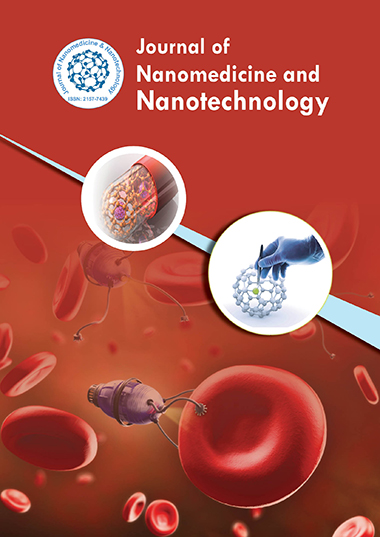
Open Access Journals
- Agri and Aquaculture
- Biochemistry
- Bioinformatics & Systems Biology
- Business & Management
- Chemistry
- Clinical Sciences
- Engineering
- Food & Nutrition
- General Science
- Genetics & Molecular Biology
- Immunology & Microbiology
- Medical Sciences
- Neuroscience & Psychology
- Nursing & Health Care
- Pharmaceutical Sciences
Research Article - (2024) Volume 15, Issue 5
An Innovation Technique in Treatment of Chronic Clot by Nano Magnetic Ablating Particles
Abbas Moghanizadeh*Received: 04-Nov-2019, Manuscript No. JNMNT-24-2619; Editor assigned: 07-Nov-2019, Pre QC No. JNMNT-24-2619 (PQ); Reviewed: 21-Nov-2019, QC No. JNMNT-24-2619; Revised: 15-Jul-2024, Manuscript No. JNMNT-24-2619 (R); Published: 12-Aug-2024, DOI: 10.35248/2157-7439.24.15.746
Abstract
Despite the current success of intra-arterial stroke therapy, there remain many challenges for chronic clot. Treatment of chronic clot poses a variety of challenges for physicians because its therapeutic alternatives have become increasingly more complex and sophisticated over time. This study aims to propose a novel therapy for chronic thrombosis by the nano magnetic ablation process. Presented Nano Magnetic Ablation (NMA) process employs magnetic force to cut off the chronic clot by nano ferromagnetic particles as cutting tools. While magnetic field pressurizes nano magnetic particles, vertically, to penetrate on the chronic clot surface, the number of nano particles play the role of cutting tools (dose of nano particles) and the rotational speed of magnet provide the horizontal force to ablate the chronic clot. This ablating mechanism enables the nano magnetic particles to slide on the chronic clot surface resulting in removing chronic clot. Several parameters govern in NMA process including magnetic field, rotational speed, nano particles dosage and thrombolytic agents.
To evaluate the effect of significant parameters on nano magnetic ablation process (percentage of removal chronic clot weight as output parameter), experiments are design and carry outed based on full factorial method. The analysis of the experimental data confirm that nano magnetic ablation has a unique potential to remove chronic clot noninvasively. The results show that magnetic field, has significant effect on the weight of removal chronic clot, while the administration thrombolytic agent, streptokinase, dose not any significant effect on ablation chronic clot and increasing the number of magnetic ablating particles (dosage of nano particles) to only a certain level, enhances the ablating process.
Keywords
Chronic clot; Nano magnetic particles; Ablation; Magnetic field
Introduction
Annually, many people suffer from various types of thrombosis across the world. Although treatment of fresh thrombosis is feasible by current therapy, eliminating chronic clots is a major challenge in medicine. Over time, the fresh clot become chronic due to the chemical processes. The clot becomes harder and scars in the vein affecting the blood flow by decreasing the vein diameter. In case of DVT, chronic clot associate with persistent pain, swelling or ulceration or disabilities and morbidity in case of chronic clot in brain capillaries. Although there are various treatments available for treating fresh clots, eliminating chronic clot requires more researches and studies to find effective treatment. One of the main challenge of treatment of chronic clot by thrombolytic agents is the time window of fibrin lytic drugs. While the majority of researches report the time window of 3 and 4.5 hours for treatment of thrombosis, Mullen shows that the average treatment time with intravenous thrombolysis is lower than 6 hours.
In most cases (more than 95%) there is a delay for initiation of treatment by administration thrombolytic agents because of going time to hospital, a lack of public awareness of stroke. There is no standard for chronic clot therapy because its depends on many factors including the accurate determination of thrombus age and maturity, however, determining the age of the thrombus is not an easy task. Although lytic therapy has effect on fresh fibrin-rich thrombi, thrombolytic agent such as tPa will not help dissolve the collagen that accumulates in an chronic clot. In addition, employing a catheter-directed thrombolysis is one way that the thrombolytic drug is injected into the site of clot to reduce the total amount of thrombolytic agent and minimize bleeding risk. The major disadvantage of systemic thrombolysis is the thrombolytic drug dose not dissolve the chronic clot. Therefore administration thrombolytic agents not only be effective after 6 hours, but also bleeding is another major challenge in administration thrombolytic agents. Invasive treatments such as open surgical is another option that be decided by a multi-disciplinary team based upon the patient's pre-morbid condition.
Being invasive, cost of surgical process and fear of surgery make it the last option for chronic venous obstructions. Contemporary surgeons benefits from pharmacomechanical adjuncts including rotational, rheolytic and ultrasoundenhanced devices for removing of chronic clot. While in rotational devices a rotating blade shave the thrombus to fragment the thrombus, in ultrasound-enhanced devices, the thrombus would be fragmented by with high-frequency, lowenergy ultrasound. Although minimally invasive approach such as percutaneous, balloon, angioplasty and stenting or a combination of them lead to removing chronic clot, some challenges including scarring, inflammation and loss of autologous bypass conduits, as well as the potential for wound breakdown and infection are associate with them. Apart from less efficacy of the thrombolytic agent, driving catheter is difficult to in the curved and small blood vessel. Researchers have suggested ways to increase the efficiency of thrombolysis by targeted drug delivery by nano particles. Researchers also show that drug delivery by nano magnetic particles in combination with magnetic field can effectively shorten thrombolysis time (87%) compared with conventional treatment with free tPA. In addition, compare with free magnetic field, applying magnetic field roughly 20% increase the efficiency of thrombolysis of fresh clot. However it is confirmed that the efficiency of clot lysis by nano particles and without any thrombus agents is negligible. Nevertheless, this technique is effective for fresh clots and there is a few report on the elimination of chronic clots by drug carrier particles.
While conventional techniques are ineffective in treatment of chronic clot, combination of different mechanisms would be one of the best strategies to eliminating of chronic clot. It is shown that the combination of hyperthermia and Nano particles carried thrombolytic agents increase the clot lysis. Another hybrid technique is employing ultrasonic and nano particles with thrombolytic agents. Preliminary, clinical experience confirm that the combination of thrombolytic agents with external ultrasound has a potential to accelerate the clot lysis, because sonication aids the thrombolytic agents to penetrate and dissolve the thrombus (of course the examined clot were not chronic one). Another strategy for lysing the clot is using the blood flow characteristics which is increasing shear stress in the stenosis vessels. It is shown that high blood flows has the potential to dislodge elements of clots to different fragments [1]. One of the novel ideas for elimination of micro thrombus by changing the blood flow is presented by Gabayno. Their innovation is based on the idea that the rotation of micro rods (because of magnet gradient) in a viscous fluid produces vortex rotational flows and the velocity flow fields apply a drag force which acts as a lift mechanism to destroy the occlusion. However, rising the blood flow or drop pressure escalate the risk of clot movement and also clot decomposition to the fragments, some of which worsen the possible rate of additional embolization on the microvasculature down-stream from the initial potion of the clot.
Due to the limitations and inefficiencies of traditional therapies in chronic clot, it is time to reassess our treatment of chronic clot and move to an era of tailored therapy that integrates current knowledge and focus efforts on novels therapies to better address the chronic thrombi that have proven more difficult to treat. Therefore, more novel therapies or techniques are strongly required beyond standard of routine thrombolysis, particularly with the development of nano technology. In this research, it has been attempted to study a novel hybrid technique for the treatment of chronic clots based on ablating process by nano magnetic particles under rotating magnetic field.
Materials and Methods
Principle of Nano Magnetic Ablation (NMA)
This research develops a new thrombectomy technique featuring the use of a rotating magnetic field to ablating the chronic clot. In the NMA process, a magnetic field is employed to provide the cutting force in order to cut off the chronic clot [2]. The magnetic field rotate around the artery (test tube here) which lead to sliding of nano magnetic particles on the surface of chronic clot, result in ablating the chronic clot as shown in the Figure 1.
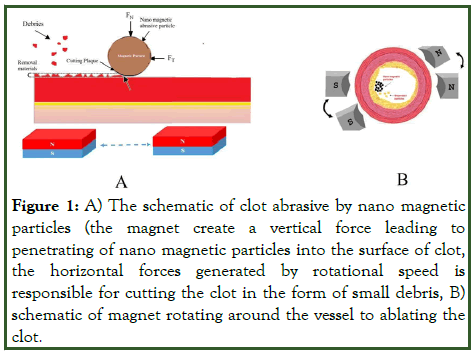
Figure 1: A) The schematic of clot abrasive by nano magnetic particles (the magnet create a vertical force leading to penetrating of nano magnetic particles into the surface of clot, the horizontal forces generated by rotational speed is responsible for cutting the clot in the form of small debris, B) schematic of magnet rotating around the vessel to ablating the clot.
As presented nano magnetic ablating is a novel process, this paper try to firstly, examine the possibility of propose therapy on removing chronic clot, secondly understand the mechanism of ablating process and the effect of process factors on the percentage of removal chronic clot weight. The factors of magnetic field, rotational speed, nano particles dosage and thrombolytic agents are considered as process factors.
Experimental setting
With the aim of exploration the relation between input and output process parameters, experiments are planned and performed based on full factorial as shown in Tables 1 and 2. Input parameters are including, magnetic field (3 levels), rotational speed (3 levels), nano magnetic dosage (3 levels), thrombolytic agent (2 levels) and the percent of removal chronic clot ablation weight is considered as a response [3].
| Input parameters | Level 1 | Level 2 | Level 3 |
|---|---|---|---|
| Magnetic field | 0.2 tesla | 0.3 tesla | 0.4 tesla |
| Rotational speed | 15 rpm | 30 rpm | 45 rpm |
| Nano magnetic dosage | 36 u gr | 3.6 mg | 36 mg |
| Thrombolytic agent | With streptokinase (7000 IU injected to test tube) | Without streptokinase |
Table 1: Levels of nano magnetic ablation of chronical clot parameters.
| Magnetic field (level) | Dosage (level) | Speed (level) | Drug (level) | Clot ablation weight (%) |
|---|---|---|---|---|
| 1 | 1 | 1 | 1 | 0.048 |
| 1 | 1 | 1 | 2 | 0.05 |
| 1 | 1 | 2 | 1 | 0.096 |
| 1 | 1 | 2 | 2 | 0.1 |
| 1 | 2 | 1 | 1 | 0.096 |
| 1 | 2 | 1 | 2 | 0.1 |
| 1 | 2 | 2 | 1 | 0.192 |
| 1 | 2 | 2 | 2 | 0.201 |
| 1 | 3 | 1 | 1 | 0.096 |
| 1 | 3 | 1 | 2 | 0.096 |
| 1 | 3 | 2 | 1 | 0.192 |
| 1 | 3 | 2 | 2 | 0.192 |
| 2 | 1 | 1 | 1 | 0.135 |
| 2 | 1 | 1 | 2 | 0.135 |
| 2 | 1 | 2 | 1 | 0.271 |
| 2 | 1 | 2 | 2 | 0.271 |
| 2 | 2 | 1 | 1 | 0.271 |
| 2 | 2 | 1 | 2 | 0.271 |
| 2 | 2 | 2 | 1 | 0.543 |
| 2 | 2 | 2 | 2 | 0.571 |
| 2 | 3 | 1 | 1 | 0.271 |
| 2 | 3 | 1 | 2 | 0.271 |
| 2 | 3 | 2 | 1 | 0.543 |
| 2 | 3 | 2 | 2 | 0.543 |
| 3 | 1 | 1 | 1 | 0.249 |
| 3 | 1 | 1 | 2 | 0.249 |
| 3 | 1 | 2 | 1 | 0.499 |
| 3 | 1 | 2 | 2 | 0.499 |
| 3 | 2 | 1 | 1 | 0.499 |
| 3 | 2 | 1 | 2 | 0.5346 |
| 3 | 2 | 2 | 1 | 0.999 |
| 3 | 2 | 2 | 2 | 1.089 |
| 3 | 3 | 1 | 1 | 0.499 |
| 3 | 3 | 1 | 2 | 0.514 |
| 3 | 3 | 2 | 1 | 0.999 |
| 3 | 3 | 2 | 2 | 0.999 |
Table 2: Design of experiments in NMA and responses.
Material used
For the synthesis of Fe3O4, iron (II) chloride tetrahydrate (FeCl2.4H2O), iron (III) chloride hexahydrate (FeCl3.6H2O) and ammonia are purchase from Merck. The streptokinase is acquired from Behring GmbH, Germany. A cubic neodymium magnet with 0.4, 0.3 and 0.2 tesla also employed.
Synthesis of nanoparticles of Fe3O4
Fe3O4 were prepared by co-precipitation of the aqueous iron salts in alkaline media under inert nitrogen purge. Firstly, FeCl3.6H2O and FeCl2.4H2O with molar proportion of 1:2, then ammonium hydroxide was added to adjust the pH to 9, also the solution was under constant magnetic stirring for 3 h [4]. Finally, black magnetite crystals were separated with neodymium magnet. Collected nano magnetic particles were washed three times with distilled water and ethanol. The products were then dried at 60°C in vacuum for 6 h for further characterizations.
Preparing chronic blood clot
Chronic clot is prepared by adding 200 μL CaCl2 to 1 cc blood in a glass tube and keeping for 72 h in normal saline in 37° to create chronic clot.
After the ablating process, the clot in glass tube is washed three times with normal saline to remove the clot derbies and nanoparticles from the test tube, then the final clot is weighed. The percentage of removal chronic clot weight is consider as an output parameter as shown in the Table 2 as below:

Abrading machine
A mechanism has been designed and prototyped to rotate the magnetic field around the test tube, the stepper motors provide precise rotational speed, which is programmed by PLC to control the rotational speed (Figure 2) [5].
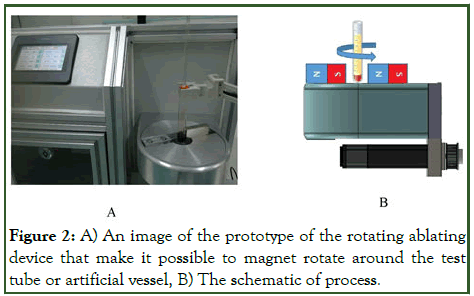
Figure 2: A) An image of the prototype of the rotating ablating device that make it possible to magnet rotate around the test tube or artificial vessel, B) The schematic of process.
Characterization of magnetic nanoparticles
In order to investigate the morphology of nano magnetic particles, TEM images are taken as shown in Figure 3A. It is estimated from the TEM images that the diameter size of nano particles are between 5 nm-20 nm. The XRD patterns of the Fe3O4 are shown in the Figure 3B [6]. Six characteristic peaks at (220), (311), (400), (422), (511) and (440) crystal planes are related to Fe3O4 with a spinal structure. The peak at (311) plane represent the most significant peak that has been employed to estimate the approximate crystallite size using Scherrer formula:

Where ‘D’ is the average crystallite size, ‘λ’ is the wavelength of X-ray,
β represents FWHM, θ is Bragg’s angle of the corresponding peak and k is the instrumental constant. The calculation show that the crystallite size of Fe3O4 (D) is 17 nm. Magnetization curves of Fe3O4 which is obtained by VSM show the saturation magnetization of Fe3O4 nanoparticles is around 60 emu g-1 as shown in Figure 3C.
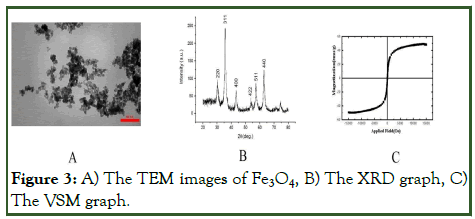
Figure 3: A) The TEM images of Fe3O4, B) The XRD graph, C) The VSM graph.
Results and Discussion
To study the ablating mechanism, the test tube wall is covered with blood clot, then the clot is eliminating by nano magnetic ablating process under rotating magnetic field. It is clear from the Figure 4 that nano particles enables to ablating the chronic clot. Nanoparticles, such as nano-knives, under magnetic fields scratch the surface of the clot. In NMA, the magnetic field applying on Nano Magnetic Particles (NMP) generates the vertical pressure that penetrates the nano magnetic particles into the surface of chronic clot [7]. Upon coupling it with rotational motion of the magnet, the clot ablation takes place. Applying a relative motion (rotational speed) between the magnetic source and the vein (test tube) makes nano magnetic particles scratch the surface of the clot and remove a thin micro or nano layer of chronic clot in the form of fine chips. During the process, nano magnetic particles form a resilient brush on the chronic clot surface, thus the nano magnetic particles act as a nano cutting tool. In the NMA technique, a magnetic field is placed around the vein (test tube here) which is including chronic clot. In a word, Nano Magnetic Ablation (NMA) is a micromachining or a nano mechanical thrombectomy process.
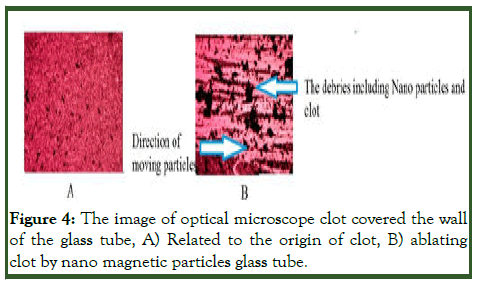
Figure 4: The image of optical microscope clot covered the wall of the glass tube, A) Related to the origin of clot, B) ablating clot by nano magnetic particles glass tube.
However, to understand the mechanism of chronic clot removal in NMA and the relationship between parameters, full factorial method and regression modelling are performed using Minitab software. Details of analysis, different main effect plots and optimized values are given below:
Regression
Based on the experimental findings the following regression models have been evolved [8]. Regression equation for the percentage chronic of clot ablation weight is given by:
The percentage of clot ablation weight(%)=-0.748+0.257 magnetic field+0.109 dosage+0.245 speed+0.0105 drug
These statistical terms of variance ratio (F) and P value are used to measure the significance of the regression under investigation [11]. The values of F and P indicates that both models are highly significant. Therefore, the regression equation for clot ablation weight can be used to predict the responses of the NMA process [9]. According to regression coefficients, the effects of magnetic field is much more than ablating speed.
Main effects of factors on removal chronic clot weight
The percentage of chronic clot ablation in NMA is significantly influenced by magnetic field (B), then by rotational speed (Figure 5). However, none of the interactions is found to be statistically significant.

Figure 5: Main effects plot for the percentage of clot ablation weight vs. magnetic field.
Study the effect of nano magnetic field: It is observed from Figure 5 that the clot ablation is directly proportional to the magnetic field strength. It could be related to the fact the penetration of nano magnetic particles on the surface of clot is proportional to the magnetic force acting on nano particles [10]. Increasing the magnetic field lead to increasing the magnetic pressure causes nano magnetic particles more penetrate on the clot surface (increasing the height of penetration). Consequently an increase in the removal chronic clot ablation is occurred (Like cutting butter with a knife, more knife insertion in butter results in more butter being separated (Magnetic particles play the role of a nano-knife).
The magnetic force and its two perpendicular components (horizontal and vertical forces) acting on magnetic particles may be expressed mathematically as given below in equations:
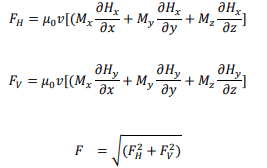
Where F is magnetic force with one component being FV as vertical force and FH as horizontal force, V is taken as MAP’s volume and H is magnetic field intensity. While the vertical force which produce by magnet is responsible for penetrating on the surface of chronic clot, the horizontal force which produce by rotational speed of magnet, acts in a tangential direction parallel to target surfaces, is responsible for cutting chronic clot.
It can be said that intensification in magnetic field, rises the normal (vertical) force acted upon the nano particles which lead to increasing in normal indentation force (lead to increasing penetration to surface as shown in the Figure 1, thus causes an growth in removal chronic clot) [11]. Therefore, by rising the magnetic field, the rate of clot ablation will be increased. However, from a biological view, the maximum amount of magnetic field that body can tolerate without damaging is a challenging issue. While using of high magnetic field of 21 tesla is reported, commercial systems are offered between 0.2 and 7T. In addition, using magnetic fields of up to 14T leads to increasing fibrin polymerization process compared to the control group. Therefore, the safe value of magnetic field applied on body should be considered for use in clinical trials.
Study the effect of nano magnetic dosage: From biological view, as human body's tolerates a certain dose of drug agent or nano particles, so that defining the number of nanoparticles (dosage) injected into the body is vital. The Figure 6 shows the effect of nano magnetic dose on the percentage of removal chronic clot ablation weight. Although magnetic particle dose initially improves the weight of removal chronic clot, after a certain dose of nano particles, adding more number of nanoparticles has no effect on improving ablation. This may indicate that only a certain number of nanoparticles are involved in the ablation (cutting) process. In fact, the magnetic field arranges the nanoparticles in a special form (like the train wagon, they are aligned vertically in the direction of the magnetic field) as shown in the Figure 7, so that only a certain number of them are in contact with the surface of the clot and participate in the cutting process [12]. Therefore, the optimal dosage of nano particles should be injected into body to reach the maximum ablating and cover the biological criteria.
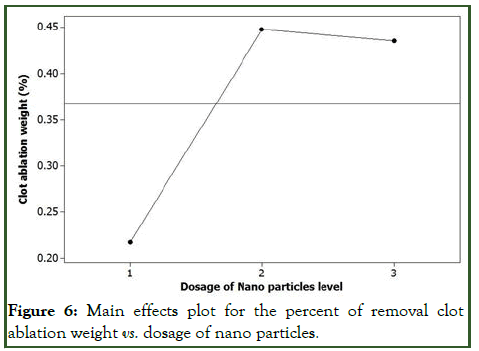
Figure 6: Main effects plot for the percent of removal clot ablation weight vs. dosage of nano particles.
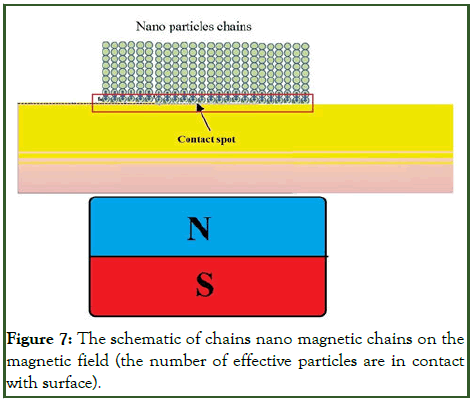
Figure 7: The schematic of chains nano magnetic chains on the magnetic field (the number of effective particles are in contact with surface).
Study the effect of rotating speed: The clot ablation improves significantly when the rotating speed is at higher level (Figure 8). Nano magnetic particles are able to remove the chronic clot in high level of rotational speed more effectively than that of low level. It is clear that the rate of clot removing depending on the relative motion between the magnetic ablating particles and surface layers of clot. This may be due to the fact that rotational speed enables the nano magnetic particles to slide on the chronic clot surface resulting in cutting off of chronic clot. Rising in rotational speed causes an increase in tangential cutting force, hence shearing of the peaks of clot layers becomes faster and thus removal chronic clot weight increase. At the same time, number of cutting edges increases, per unit time, by increasing the speed of particles. Therefore, more peaks of chronic clot surface are sheared at high rpm.
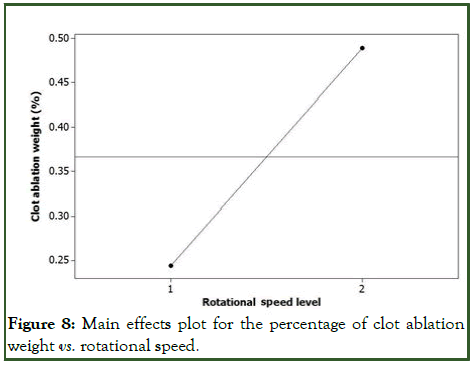
Figure 8: Main effects plot for the percentage of clot ablation weight vs. rotational speed.
Study the effect of administration thrombolytic agent: The results, as expected, confirm that the thrombolytic agent has no significant effect on clot ablation weight (Figure 9). It should be mentioned that researchers have shown that thrombolytic drugs are not able to resolve chronic clots because the thrombus evolves structurally over time with complex changes and chronic clots are more resistant to drug. As a result, the fibrin breakable drug is not effective for dissolving the chronic clot. This indicates that the mechanical process dominant in nano magnetic ablation.
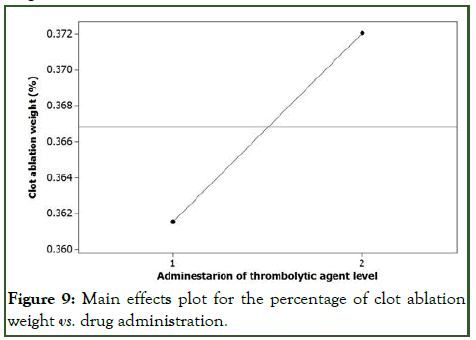
Figure 9: Main effects plot for the percentage of clot ablation weight vs. drug administration.
Conclusion
While traditional thrombolysis of chronic clots is a major challenge in medicine, this research develop a new technique of ablating. This research confirm that ablation of chronic clot by nano magnetic articles is a viable solution for treatment of chronic clot. The main merit of this technique is that make it possible to remove the chronic clot by only nano magnetic particles while administration drug are not able to dissolve it. Although this method is still in the early stages of research, these results indicate that it is capable of being used in animal research.
The experimental analysis on nano magnetic ablation of chronic clot leads to the following conclusions:
• It is observed that the removal clot ablating weight is
significantly influenced by magnetic field. This effect is
explained by rising magnetic pressure on nano magnetic
particles. Increasing magnetic force leads to more penetrating
of nano magnetic particles on surface of clot resulting cutting
off more volume of clot.
• Improvement in the chronic clot ablation is directly
proportional to rotational speed. In fact the horizontal force
which produce by rotational speed of magnet, acts as a cutting
force and increasing the rotational speed lead to increasing the
tangential force resulting more ablating occurred.
• Although clot ablation weight increase by risisng the initial
dosage of nano particles, however, as the nanoparticles
increase again, the ablation of the clot remains constant.
Because a certain number of nano particles play the role of
cutting edges. Streptokinase as a thrombolytic drug does not
show any significant effect on the ablating chronic clot.
References
- Jenkins DP, Madani M, Mayer E, Kerr K, Kim N, Klepetko W, et al. Surgical treatment of chronic thromboembolic pulmonary hypertension. Eur Respir J. 2013;41(3):735-742.
[Crossref] [Google Scholar] [PubMed]
- Cohen AT, Agnelli G, Anderson FA, Arcelus JI, Bergqvist D, Brecht JG, et al. Venous Thromboembolism (VTE) in Europe. Thromb Haemost. 2007;98(10):756-764.
[Google Scholar] [PubMed]
- Ashrani AA, Heit JA. Incidence and cost burden of post-thrombotic syndrome. J Thromb Thrombolysis. 2009;28:465-476.
[Crossref] [Google Scholar] [PubMed]
- Saha P, Black S, Breen K, Patel A, Modarai B, Smith A. Contemporary management of acute and chronic deep venous thrombosis. Br Med Bull. 2016;117(1):107-120.
[Crossref] [Google Scholar] [PubMed]
- Pivkin IV, Richardson PD, Karniadakis G. Blood flow velocity effects and role of activation delay time on growth and form of platelet thrombi. Proc Natl Acad Sci. 2006;103(46):17164-17169.
[Crossref] [Google Scholar] [PubMed]
- Ouriel K, Welch EL, Shortell CK, Geary K, Fiore WM, Cimino C. Comparison of streptokinase, urokinase and recombinant tissue plasminogen activator in an in vitro model of venous thrombolysis. J Vasc Surg. 1995;22(5):593-597.
[Crossref] [Google Scholar] [PubMed]
- Lees KR, Bluhmki E, Von Kummer R, Brott TG, Toni D, Grotta JC, et al. Time to treatment with intravenous alteplase and outcome in stroke: An updated pooled analysis of ECASS, ATLANTIS, NINDS and EPITHET trials. Lancet. 2010;375(9727):1695-1703.
- Del Zoppo GJ, Saver JL, Jauch EC, Adams Jr HP. Expansion of the time window for treatment of acute ischemic stroke with intravenous tissue plasminogen activator: A science advisory from the American Heart Association/American Stroke Association. Stroke. 2009;40(8):2945-2948.
[Crossref][Google Scholar] [PubMed]
- Paul CL, Ryan A, Rose S, Attia JR, Kerr E, Koller C, et al. How can we improve stroke thrombolysis rates? A review of health system factors and approaches associated with thrombolysis administration rates in acute stroke care. Implement Sci. 2015;11:1-2.
[Crossref] [Google Scholar] [PubMed]
- Mullen MT, Pisapia JM, Tilwa S, Messe SR, Stein SC. Systematic review of outcome after ischemic stroke due to anterior circulation occlusion treated with intravenous, intra-arterial or combined intravenous+intra-arterial thrombolysis. Stroke. 2012;43(9):2350-2355.
[Crossref] [Google Scholar] [PubMed]
- Bambauer KZ, Johnston SC, Bambauer DE, Zivin JA. Reasons why few patients with acute stroke receive tissue plasminogen activator. Arch Neurol. 2006;63(5):661-664.
[Crossref] [Google Scholar] [PubMed]
- Hacke W, Kaste M, Bluhmki E, Brozman M, Davalos A, Guidetti D, et al. Thrombolysis with alteplase 3 to 4.5 hours after acute ischemic stroke. N Engl J Med. 2008;359(13):1317-1329.
[Crossref] [Google Scholar] [PubMed]
Citation: Moghanizadeh A (2024) An Innovation Technique in Treatment of Chronic Clot by Nano Magnetic Ablating Particles. J Nanomed Nanotech. 15:746.
Copyright: © 2024 Moghanizadeh A. This is an open-access article distributed under the terms of the Creative Commons Attribution License, which permits unrestricted use, distribution, and reproduction in any medium, provided the original author and source are credited.
